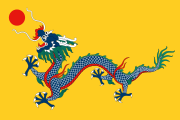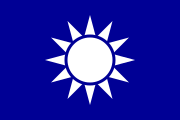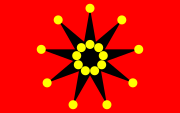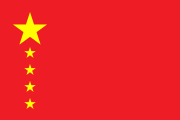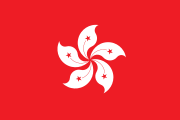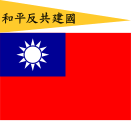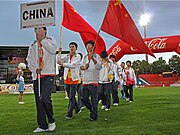Flag of China
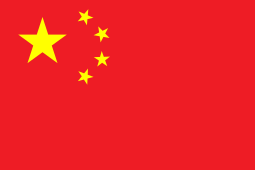 | |
| Five-star Red Flag[1] | |
| Use | Civil and state flag, civil and state ensign |
|---|---|
| Proportion | 2:3 |
| Adopted |
|
| Design | A large golden star within an arc of four smaller golden stars, in the canton, on a field of Chinese red. |
| Designed by | Zeng Liansong |
| Flag of China | |||||||||||||||
|---|---|---|---|---|---|---|---|---|---|---|---|---|---|---|---|
| Simplified Chinese | 中国国旗 | ||||||||||||||
| Traditional Chinese | 中國國旗 | ||||||||||||||
| Literal meaning | State flag of China | ||||||||||||||
| |||||||||||||||
| Flag of the People's Republic of China | |||||||||||||||
| Simplified Chinese | 中华人民共和国国旗 | ||||||||||||||
| Traditional Chinese | 中華人民共和國國旗 | ||||||||||||||
| Literal meaning | State flag of the People's Republic of China | ||||||||||||||
| |||||||||||||||
| Five-star Red Flag | |||||||||||||||
| Simplified Chinese | 五星红旗 | ||||||||||||||
| Traditional Chinese | 五星紅旗 | ||||||||||||||
| |||||||||||||||
The national flag of the People's Republic of China, also known as the Five-star Red Flag,[1] is a Chinese red field with five golden stars charged at the canton. The design features one large star, with four smaller stars in an arc set off towards the fly. It has been the national flag of China since the foundation of the People's Republic of China on 1 October 1949. The flag was designed by Zeng Liansong.
The red represents the Chinese Communist Revolution. The five stars and their relationships to each other represent the unity of four social classes of Chinese people, symbolized by four smaller stars, under the Chinese Communist Party (CCP), symbolized by the large star. The flag was first hoisted by the People's Liberation Army (PLA) on a pole overlooking Beijing's Tiananmen Square on 1 October 1949, at a ceremony proclaiming the establishment of the People's Republic of China.
History
[edit]Early flags
[edit]The previous flag of China was the "Yellow Dragon Flag" used by the Qing dynasty — the last imperial dynasty in Chinese history— from 1862 until the overthrow of the monarchy during the 1911 Revolution. The flag that was adopted in 1862 was triangular, but the dynasty adopted a rectangular version of the dragon flag in 1889.
Republic of China
[edit]-
 Flag of the Beiyang government (1912–1928).
Flag of the Beiyang government (1912–1928). -
 "Blue Sky with a White Sun" flag (青天白日旗). Kuomintang party flag and the ROC naval jack (1895–present)
"Blue Sky with a White Sun" flag (青天白日旗). Kuomintang party flag and the ROC naval jack (1895–present) -
 Flag of the Republic of China Army.
Flag of the Republic of China Army.
--The canton (upper corner on the hoist side) originated from the "Blue Sky with a White Sun flag" (青天白日旗; qīngtiān báirì qí) designed by Lu Haodong, a martyr of the 1911 Revolution. He presented his design to represent the revolutionary army at the inauguration of the Society for Regenerating China, an anti-Qing society in Hong Kong, on 21 February 1895. This design was later adopted as the KMT party flag and the Coat of Arms of the Republic of China. The "red Earth" portion was added by Sun Yat-sen in the winter of 1906, bringing the flag to its modern form. According to George Yeo, the then Foreign Minister of Singapore in 2011, in those days, the Blue Sky with a White Sun flag was sewn in the Sun Yat Sen Nanyang Memorial Hall (formerly known as the "Sun Yat Sen Villa") in Singapore by Teo Eng Hock and his wife.[3][4] The drafted design had ten stripes with the flag of the Kuomintang in the canton that resembled the flags of the United States, Malaysia, and Liberia.[citation needed]
During the Wuchang Uprising in 1911 that heralded the Republic, the various revolutionary armies had different flags. Lu Hao-tung's "Blue Sky with a White Sun" flag was used in the provinces of Guangdong, Guangxi, Yunnan, and Guizhou. In Wuhan, a flag with 18 yellow stars was used to represent the 18 administrative divisions at the time. In Shanghai and northern China, a "Five-Colored Flag" (五色旗; wǔ sè qí) (Five Races Under One Union flag) was used of five horizontal stripes representing the five major nationalities of China: the Han (red), the Manchu (yellow), the Mongol (blue), the Hui (white), and the Tibetan (black).[citation needed]
When the government of the Republic of China was established on 1 January 1912, the "Five-Colored Flag" was selected by the provisional Senate as the national flag. The "18-Star Flag" was adopted by the army[5] and the modern flag was adopted as a naval ensign.[6] Sun Yat-sen, however, did not consider the five-colored flag appropriate, reasoning that horizontal order implied a hierarchy or class like that which existed during dynastic times.[citation needed]
After President Yuan Shikai assumed dictatorial powers in 1913 by dissolving the National Assembly and outlawing the KMT, Sun Yat-sen established a government-in-exile in Tokyo and employed the modern flag as the national ROC flag. He continued using this design when the KMT established a rival government in Guangzhou in 1917. The modern flag was made the official national flag on 17 December 1928 after the successful Northern Expedition that overthrew the Beijing government, though the Five-Colored Flag still continued to be used by locals in an unofficial capacity. One reason for this discrepancy in use was lingering regional biases held by officials and citizens of northern China, who favored the Five-Colored Flag, against southerners such as the Cantonese/Hakka Sun Yat-sen.[citation needed]
During the Second Sino-Japanese War, the invading Japanese established a variety of puppet governments using several flag designs. The "Reform Government", established in March 1938 in Nanjing to consolidate the various puppet governments, employed the Five-Colored Flag. When Wang Jingwei was slated to take over the Japanese-installed government in Nanjing in 1940, he demanded to use the modern flag as a means to challenge the authority of the Nationalist Government in Chongqing under Chiang Kai-shek and position himself as the rightful successor to Sun Yat-sen. However, the Japanese preferred the Five-Colored flag. As a compromise, the Japanese suggested adding a triangular yellow pennant on top with the slogan "Peace, Anticommunism, National Construction" (和平反共建國; Hépíng fǎngòng jiàn guó) in black, but this was rejected by Wang. In the end, Wang and the Japanese agreed that the yellow banner was to be used outdoors only until 1943, when the banner was abandoned, leaving two rival governments with the same flag, each claiming to be the legitimate national government of China.[7]
After the Chinese Civil War in 1949, the ROC government led by Chiang Kai-shek relocated its government and its institutions to the island of Taiwan. On the mainland, CCP forces of Mao Zedong established the People's Republic of China (PRC) and adopted their own national flag. On 23 October 1954, the National Emblem and National Flag of the Republic of China Act (中華民國國徽國旗法; Zhōnghuá Mínguó guóhuī guóqífǎ) was promulgated by the Legislative Yuan to specify the size, measure, ratio, production, and management of the flag.[8]
People's Republic of China
[edit]On 4 July 1949, the sixth working group of the Preparatory Committee of the New Political Consultative Conference (新政治協商會議籌備會, PCNPCC) created a notice to submit designs for the national flag. After subsequent revisions, the notice was published in the papers People's Daily, Beiping Liberation News, Xinmin News, Dazhong Daily, Guangming Daily, Jinbu Daily and Tianjin Daily during the period 15–26 July.[9] The list of requirements for the national flag were also posted in the notice:
- Chinese characteristics (geography, nationality, history, culture, etc.);
- Power characteristics (people's democratic government, led by the working class and based on the worker-peasant alliance);
- The shape should be rectangular and the length-breadth ratio should be 3:2;
- The color should mainly be bright red[10] (an early draft of the notice had the color as dark red, but this was changed to bright red by Zhou Enlai).[11]
Zeng Liansong, a citizen from Wenzhou, Zhejiang, was working in Shanghai when the announcement came out; he wanted to create a flag design to express his patriotic enthusiasm for the new country. In the middle of July, he sat down in his attic over the course of several nights to come up with designs. His inspiration for the current design came from observing how stars shine in the night sky. He thusly thought of a Chinese proverb, "longing for the stars, longing for the moon" (盼星星盼月亮, pàn xīngxīng pàn yuèliàng), which shows yearning. He viewed the CCP as the great savior (大救星, dà jiùxīng "great saving star") of the Chinese people, symbolized by the flag's largest star. The idea for four small stars came from "On the People's Democratic Dictatorship", a speech by Mao Zedong, which defined the Chinese people as consisting of four social classes, also traditionally referred to in Asian cultures as the four occupations (士農工商, shì nóng gōng shāng) ("Scholars, Peasants, Workers, Merchants"). The color yellow implies that China belongs to the Chinese people, a "yellow race".[11] After working out the details of the placement of the stars and their sizes (he had tried to put all of the stars in the center, but thought this too dull), he sent his "Five Stars on a Field of Red" (紅地五星旗, hóng dì wǔxīng qí) design to the committee in the middle of August.[2][11]
By 20 August, between 2,992[12] and 3,012[13] designs had been sent to the flag committee,[14] including input from committee members themselves such as Guo Moruo and Tan Kah Kee.[12] From 16 to 20 August, the designs were viewed at the Beijing Hotel and culled down to a list of 38.[2][9] These designs are collected into a book named A Reference of National Flag Designs (國旗圖案參考資料). This book was then submitted to the newly established Chinese People's Political Consultative Conference (CPPCC) for further discussion. However, Zeng's design was not included until Tian Han nominated it again.[15]

On the morning of 23 September, the representatives of the CPPCC discussed the national flags, but came to no conclusion. Some disliked the symbolism which Zeng attached to the four smaller stars, and said it should not include the bourgeoisie. The design Mao and others liked had a giant golden star in the corner on a red flag that was charged with a golden horizontal bar. But this design was strongly opposed by Zhang Zhizhong, who saw the golden bar as symbolizing China being divided into two.[16] That night, Peng Guanghan (彭光涵) recommended Zeng's design to Zhou Enlai. Zhou was satisfied with it and asked for the creation of a larger copy of the design. Tan Kah Kee also gave his advice to Mao and Zhou that the power characteristics take precedence over Chinese geography characteristics, so there was no need to insist on the golden bar that symbolized the Yellow River. Two days later, Mao had a meeting in his office about the flag. He persuaded everyone to adopt Zeng's design, with some slight modifications.[17] According to earlier discussions at the Beijing Hotel, the hammer and sickle from Zeng's original design was removed since it was similar to the flag of the Soviet Union.[15] On 27 September 1949, Zeng's modified design was selected unanimously by the First Plenary Session of CPPCC, which changed the flag's name to "Five-star Red Flag".[2][18]
On 29 September, the new flag was published in the People's Daily, so the design could be copied by other local authorities.[19] The flag was officially unveiled and raised for the first time by Mao Zedong in Beijing's Tiananmen Square on 1 October 1949, at the formal announcement of the People's Republic of China. The first flag flown over Tiananmen Square was sewn together by Zhao Wenrui (赵文瑞), a seamstress who finished the task around 1 pm on 30 September.[20] Zeng had a hard time believing that his design was picked, due to the missing hammer and sickle from the giant star. However, he was officially congratulated by the General Office of the Central People's Government as the designer of the flag and received 5 million yuan for his work.[11][21]
-
 The original design submitted by Zeng Liansong.
The original design submitted by Zeng Liansong.
-
 Proposal by Wu Yuzhang
Proposal by Wu Yuzhang -
 Proposal by Ai Qing
Proposal by Ai Qing -
 Proposal by Zhu De
Proposal by Zhu De -
 Proposal by Liang Congjie
Proposal by Liang Congjie -
 Proposal by Guo Moruo
Proposal by Guo Moruo -
 Proposal by Guo Moruo
Proposal by Guo Moruo
Symbolism
[edit]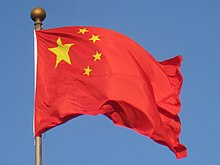
According to the official government interpretation of the flag, the red background symbolizes the Chinese Communist Revolution. The five stars and their relationship represents the unity of Chinese people under the leadership of the CCP. The orientation of the stars shows that the unity should revolve around a center.[13] The larger star symbolizes the CCP, and the four smaller stars that surround the big star symbolize the four social classes of China's New Democracy mentioned in Mao's "On the People's Democratic Dictatorship": the working class, the peasantry, the urban petite bourgeoisie, and the national bourgeoisie.[22] It is sometimes stated that the five stars of the flag represent the five largest ethnic groups: Han Chinese, Zhuangs, Hui people, Manchus and Uyghurs.[23][24] This is generally regarded as an erroneous conflation with the "Five Races Under One Union" flag, used 1912–28 by the Beiyang Government of Republic of China, whose different-colored stripes represented the Han Chinese, Hui people, Manchus, Mongols and Tibetans.[23][25]
Construction details, sizes and colors
[edit]The construction sheet for the national flag was published on 28 September 1949 by an order from the Presidium of the First Plenary Session of the CPPCC.[26] The information can also be found in the document "GB 12982-2004: National flag" that was released by the Standardization Administration of China.[27]
| Construction sheet | Standard |
|---|---|

|
|
During the 2016 Summer Olympics in Rio de Janeiro, flags that failed to adhere to the regulations were used in connection with China. The flags, used during the opening ceremony and two medal ceremonies, featured the four small stars incorrectly angled in the same direction, eliciting both fury at and a subsequent apology from the Olympic organizers.[29]
The Law on the National Flag mentions five possible sizes that could be made for the national flag:[30] According to Article 4 of the Law On the National Flag, people's governments of provinces, autonomous regions and municipalities directly under the Central Government are directed to authorize companies to make any copy of the national flag.[26] Besides five official sizes for flying on flagpoles, there are another four smaller sizes for other purposes, such as decoration on cars or display in meeting rooms.[31]
| Size | 1 | 2 | 3 | 4 | 5 | 6 | 7 | 8 | 9 |
|---|---|---|---|---|---|---|---|---|---|
| Length × width (cm) | 288 × 192 | 240 × 160 | 192 × 128 | 144 × 96 | 96 × 64 | 66 × 44 | 45 × 30 | 30 × 20 | 21 × 14 |
Colors
[edit]The colors of the national flag are stipulated in the document "GB 12983-2004: Standard Color Sample of the National Flag", and promulgated by the Standardization Administration of China. The colors are in specified in CIE 1964 xyY10 color space under standard illuminant D65.[32]
| Fabric | Luminance Y10 | Color coordinate | Allowable error margin | ||
|---|---|---|---|---|---|
| x10 | y10 | ||||
| Synthetic fiber | Red | 9.4 | 0.555 | 0.328 | All are |
| Gold | 41.2 | 0.446 | 0.489 | ||
| Silk | Red | 12.3 | 0.565 | 0.325 | |
| Gold | 32.4 | 0.450 | 0.463 | ||
| Cotton cloth | Red | 9.2 | 0.595 | 0.328 | |
| Gold | 33.0 | 0.467 | 0.463 | ||
| Sleeve | White | 78.0 | – | – | The luminance Y10 must not be less than 78 |
For computer display, the National Flag Law defers to "standard" PNG images posted on the National People's Congress website.[33] The specific colors used, in the sRGB space of the PNG file, are:[34]
| Red | Yellow | |
|---|---|---|
| RGB | 238/28/37 |
255/255/0
|
| Hexadecimal | #EE1C25 |
#FFFF00
|
| CMYK | 0/88/84/7 |
0/0/100/0
|
Unicode
[edit]The Flag of China is represented as the Unicode emoji sequence U+1F1E8 🇨 REGIONAL INDICATOR SYMBOL LETTER C and U+1F1F3 🇳 REGIONAL INDICATOR SYMBOL LETTER N.[35]
Regulations
[edit]The current law about the national flag was passed by 14th Meeting of the Standing Committee of the Seventh National People's Congress on 28 June 1990 and was enforced starting 1 October 1990. The main point of the law was to set down regulations on how to make the Chinese flag, what it looks like, where it can be flown and how it can be flown. The law also stresses that the national flag is "the symbol and hallmark of the People's Republic of China" and that everyone "shall respect and care for the National Flag".[26]
Guidelines for flag display
[edit]
The National Flag Law of the People's Republic of China has made detailed regulations on places or institutions for raising the national flag. Specifically, it stipulates the flag must be hung daily at Tiananmen Square, the Gate of New China, the Standing Committee of the National People's Congress, the State Council, the Chinese People's Political Consultative Conference, the Supreme People's Procuratorate, immigration agencies, ports, railway stations and other ports of entry, among other places. The flag should be hung at various departments of the State Council, the standing committees of local people's congresses at all levels, courts, and local committees of the Chinese People's Political Consultative Conference or property belonging to said places or institutions on working days. National flags should be raised in full-time schools except on vacations and Sundays.
Priority in processions
[edit]According to Article 15 of the Law on the National Flag, "the national flag, when raised or carried in a procession with another flag or flags, shall be in front of the other flag or flags." However, incidents violating the aforementioned provisions, such as the CCP flag leading the national flag, have occurred.
Folding the flag
[edit]- Fold horizontally along the center.
- Repeat, fold horizontally along the center.
- Fold vertically along the center of the flag.
- Repeat, fold vertically along the center of the flag.
- Repeat, fold vertically along the center of the flag.
- Repeat, fold vertically along the top
Desecration
[edit]
Flag desecration is prohibited in China. The penal code[36] provides for imprisonment up to three years, criminal detention, public surveillance, or deprivation of political rights for "whoever desecrates the National Flag or the National Emblem of the People's Republic of China by intentionally burning, mutilating, scrawling on, defiling or trampling upon it in a public place". Some Taiwanese groups have burned the Chinese flag in protest of the PRC government.[37]
On 29 September 2017, Hong Kong elected legislator Cheng Chung-tai was convicted of desecrating the flag under the National Flag and National Emblem Ordinance.[38][original research?] He had been seen turning representations of the flags (not of standard dimensions) upside down in the legislative chamber in October of the previous year.[39]
Flags of the Special Administrative Regions of the People's Republic of China
[edit]
Due to an order passed by the CCP Central Committee General Office and General Office of the State Council, cities and provinces are no longer allowed to adopt their own symbols.[40] However, both of the Hong Kong and Macau Special Administrative Regions of China have their own special flags. The precise use of the SAR flags are regulated by laws passed by the National People's Congress.[41][42]
The Flag of the Hong Kong Special Administrative Region features a stylized, white, five-petal Bauhinia blakeana flower in the center of a red field. On each petal is a red star; they symbolise Hong Kong's status under China, while the overall flag design signifies the reestablished link between postcolonial Hong Kong and China while demonstrating the "One country, two systems" political principle applied to the region.[43][44] The flag of Hong Kong was adopted on 16 February 1990.[45] On 10 August 1996, it received formal approval from the Preparatory Committee, a group which advised the People's Republic of China (PRC) on Hong Kong's transfer of sovereignty from the United Kingdom to the PRC in 1997.[41] The flag was first officially hoisted on 1 July 1997, in the handover ceremony marking the transfer of sovereignty from the United Kingdom to China.[46]
The Regional flag of the Macau Special Administrative Region is "Macau green" with a lotus flower above a stylized image of the Governor Nobre de Carvalho Bridge and water in white, beneath an arc of five gold, five-pointed stars: one large star in the center of the arc and four smaller ones. The lotus was chosen as the floral emblem of Macau. The Governor Nobre de Carvalho Bridge is a bridge linking the Macau Peninsula and the island of Taipa.[47] The bridge is one of the most recognizable landmarks of the territory. The water beneath the lotus and the bridge symbolize Macau's position as a port and its role played in the territory. The five five-pointed stars echo the design of the national flag, symbolizing the relationship Macau has with its mother country.[48] The design was chosen on 15 January 1993 by a committee that was drafting the Basic Law for the Macau SAR and was formally adopted by the Macau SAR Preparatory Committee on 16 January 1999.[49] The flag was first officially hoisted on 20 December 1999, in the handover ceremony marking the transfer of sovereignty from Portugal to China.[50]
Military flags
[edit]There are six flags that are used by the People's Liberation Army (PLA). The main feature of these flags is a golden star at the top left corner and two Chinese characters "八一" to the right of the star, all placed on a red background. The characters "八一" (literally "eight one") pay homage to the events on 1 August 1927 (8th month, 1st day); this was when the PLA was created by the CCP to start their rebellion against the Kuomintang Government in Nanchang.[51] The main flag of the PLA was created on 15 June 1949 by a decree issued from Mao.[52] The flag has a ratio of 5 by 4, which has a white sleeve measuring 1⁄16 of the flag's length. For ceremonies, a PLA flag with golden fringe is placed on a pole with gold and red spiral stripes and topped with a golden finial and red tassel.[53] Each branch of the PLA, the Ground Forces, Navy, Air Force and Rocket Force, also have their own flags to use. In a 1992 order, the flags of the three branches were defined. The top 5⁄8 of the flags is the same as the PLA flag; the bottom 3⁄8 are occupied by the colors of the branches.[54] The flag of the Ground Forces has a forest green bar at the bottom, the naval ensign has stripes of blue and white at the bottom, the Air Force uses a sky blue bar and the Rocket Force uses a yellow bar at the bottom. The forest green represents the earth, the blue and white stripes represent the seas, the sky blue represents the air and the yellow represents the flare of missile launching.[55][56]
On 10 January 2018, the People's Armed Police received a new flag following the design of the PLA branch flags with three olive stripes at the bottom.[57]
CCP flags
[edit]After the CCP was founded in 1920, various sections of the party made flags based on what the Bolsheviks used, producing various designs and patterns. The current flag of the CCP was not created until 28 April 1942. On that date, the CCP Central Committee Political Bureau issued a decree announcing the flag and the pattern it should follow.[58] The design was further defined in the CCP Constitution in 1996.[59] The flag has a red background that is charged with the emblem of the CCP in gold at the top left corner.[60] The flag ratio is defined as two by three (24×36 units); the size of the emblem is eight units square, placed four units away from the hoist and three units away from the top of the flag.[59]
The flag of the Communist Youth League of China was adopted on 4 May 1950. The design of the flag consists of the group emblem, a gold star surrounded by a ring of gold, charged on a red field. The construction of the flag consists of making the top hoist portion of the flag into twelve by eighteen units, placing the emblem in the middle of that rectangle. The radius of the emblem is four units.[61]
The Young Pioneers of China currently uses two flags. The first flag is for pioneer battalions. The length of this flag is 90 centimeters (35 in); its width,120 centimeters (47 in). A golden badge of the Young Pioneers is placed in the center of the flag. However, for a company, a second, modified flag is used. The flag has a length of 60 centimeters (24 in) and a width of 80 centimeters (31 in). A 20 centimeters (7.9 in) triangle is cut out of the fly edge of the flag and the golden emblem is shifted closer towards the hoist.[62]
Customs flag
[edit]

 Customs flag of China
Customs flag of ChinaThe customs flag is the Chinese national flag with the emblem of customs at the lower right corner, which consists of a golden key and the Caduceus of Hermes, crossing each other. The current customs flag was officially adopted on 1 October 1953. The customs flag should be hung at the bow of the customs vessel.[63]
Historical and foreign-influenced flags
[edit]-
 Flag of the Qing dynasty (1862–1889)
Flag of the Qing dynasty (1862–1889) -
 Flag of the Qing dynasty (1889–1912)
Flag of the Qing dynasty (1889–1912) -
 National flag of Empire of China 1916
National flag of Empire of China 1916 -
Flag of the Republic of China (1928–present)
-
Flag of the National Revolutionary Army (1928–1947) and the flag of the Republic of China Army (1947–present)
-
Flag of the Kuomintang and the naval jack of the Republic of China Navy (1947–present)
-
Flag of Chinese Taipei used by ROC (1984–present)
-
 Flag of the Chinese Soviet Republic (1931–1937)
Flag of the Chinese Soviet Republic (1931–1937) -
 The flag of the Reorganized National Government of the Republic of China, a Japanese puppet state during World War II, was based on the Flag of the Republic of China.
The flag of the Reorganized National Government of the Republic of China, a Japanese puppet state during World War II, was based on the Flag of the Republic of China. -
 National flag of Manchukuo (1932–1945)
National flag of Manchukuo (1932–1945) -
 Imperial Japanese flag used in Kwantung Leased Territory (1905–1945), Taiwan (1895–1945) and occupied parts of southeastern China (1937–1945)
Imperial Japanese flag used in Kwantung Leased Territory (1905–1945), Taiwan (1895–1945) and occupied parts of southeastern China (1937–1945)
Gallery
[edit]-
The PRC flag on an Air China Boeing 747-400.
-
Yao Ming holding the PRC flag during the 2008 Summer Olympics Parade of Nations.
-
PRC flag flying in the middle of Tiananmen Square.
-
Protesters waving PRC and ROC flags during an anti-Japan demonstration in Hong Kong in 2012.
-
Flag of the PRC flying in the 2015 Victory Day Parade.
-
PRC embassy in Nuku'alofa, Tonga with its national flag.
-
Chinese delegates with the PRC flag marching into the stadium for the World Sports Festival.
-
The PRC flag on the uniform of Shenzhou 5 spaceflight mission.
-
A man in San Francisco holding the PRC flag during the torch relay for the 2008 Summer Olympics.
-
The People's Liberation Army with the PRC banner during the 2015 Moscow Victory Day Parade.
-
Chinese students with the PRC flag at École Polytechnique.
-
The flag of the PRC flown on the Great Wall of China.
See also
[edit]- List of Chinese flags
- Emblem of the People's Republic of China
- March of the Volunteers
- Flag of the Republic of China
- Red flag
Notes
[edit]References
[edit]- ^ a b 马全洲; 周凯军 (1 April 2009). Stories About the National Flag, Emblem and Anthem. Beijing, China: People's Liberation Army Publishing House. p. 1. ISBN 978-7-5065-5729-0.
- ^ a b c d 1949年9月27日 中华人民共和国国旗诞生 [27 September 1949: The Birth of PRC's Flag]. CPC News (in Simplified Chinese). Archived from the original on 11 March 2012. Retrieved 4 November 2009.
- ^ "MFA Press Release Admin Page". 10 June 2011. Archived from the original on 10 June 2011.
- ^ "万圊远 Real Estate – 万圊远 Real Estate". Archived from the original on 26 November 2009.
- ^ Yu-liang, Tai (23 October 1954). 中國歷代陸軍旗幟 (in Chinese). Retrieved 26 December 2008.
- ^ Cheung, Andrew (1995). "Slogans, Symbols, and Legitimacy: The Case of Wang Jingwei's Nanjing Regime". Working paper. East Asian Working Paper Series on Language and Politics in Modern China. Archived from the original on 26 February 2008. Retrieved 24 July 2008.
{{cite journal}}: Cite journal requires|journal=(help) - ^ Tai, Yu-liang (23 October 1954). 中華民國國徽國旗法 (in Chinese (Taiwan)). Retrieved 26 December 2008.
- ^ a b "Creation of the Flag, Emblem and Anthem of the People's Republic of China". Chinese Government News (in Chinese (China)). 8 October 2006. Archived from the original on 13 October 2008. Retrieved 5 November 2009.
- ^ PCNPCC (10 July 1949). 新政治協商會議籌備會爲徵求國旗國徽圖案及國歌辭譜啓事 [Notice to Solicit Designs of the National Flag, Emblem and Anthem]. Wikisource (in Traditional Chinese). Retrieved 5 November 2009.
- ^ a b c d Kong, Mark (1 October 1999). "The Worker Who Forged the Red Flag". Beijing This Month. Chinese Business World. Archived from the original on 11 February 2009. Retrieved 3 November 2009.
- ^ a b Chen, Yu (13 August 2009). "The National People's active participation in the design within 1 month of flag design up to 2992 candidates". CPC News (in Chinese). Archived from the original on 9 February 2011. Retrieved 5 November 2009.
- ^ a b "National Flag of the People's Republic of China" (in Chinese). Gov.cn. 24 May 2005. Archived from the original on 9 October 2019. Retrieved 8 November 2009.
- ^ Zhu, Weiqun, ed. (2008). "2, Work of the Preparatory Committee of the New Political Consultative Conference (4)". 1948–2008, Let history tell the future – the CPC Central Committee issued "51 slogan" 60 anniversary (in Chinese (China)). China Publishing House. ISBN 978-7-5075-2294-5. Archived from the original on 9 March 2010. Retrieved 5 November 2009.
- ^ a b Bai, Zhi (22 July 1999). "How Was The National Flag Created?" (in Chinese). Digest News. Retrieved 6 November 2009.
- ^ Tian, Shuhe (13 February 2009). "Zhang Zhizhong and the Birth of the 5 Star Red Flag". CPC News (in Chinese (China)). Archived from the original on 16 August 2019. Retrieved 5 November 2009.
- ^ Peng Guanghan (March 2003). "Witnesses to the Birth of the National Flag". At Home and Overseas (in Chinese). Beijing: The All-China Federation of returned overseas Chinese and overseas Chinese. ISSN 1002-3801.
- ^ Wang Jianzhu (9 October 2009). "Peng Han: the tortuous process of the flag's birth" (in Chinese). CPC News. Retrieved 5 November 2009.
- ^ "People's Daily" (Image) (in Chinese). 466. 29 September 1949: 1. Retrieved 6 November 2009.
{{cite journal}}: Cite journal requires|journal=(help) - ^ "The first one who stitched the flag of The People's Republic of China – Zhao Wenrui" (in Chinese). QQ.com. 7 August 2008. Archived from the original on 15 July 2011. Retrieved 6 November 2009.
- ^ Han Tailun (2000). Witnessed the Tiananmen Square (in Chinese). Vol. 3. Xi'an: Shaanxi People's Publishing House. p. 2066. ISBN 978-7-224-05364-7.
- ^ Lin, Chun (2006). The transformation of Chinese socialism. Durham [N.C.]: Duke University Press. p. 150. ISBN 978-0-8223-3785-0. OCLC 63178961.
- ^ a b Shambaugh, David (June 1994). "Book reviews". The China Quarterly (138). CUP for SOAS: 517–520. doi:10.1017/S0305741000035876.
- ^ Mayall, James (1998). "Nationalism". The Columbia History of the 20th Century. ed. Richard W. Bulliet. Columbia University Press. pp. 186. ISBN 0-231-07628-2.
- ^ Zarrow, Peter Gue (2005). "Revolution and Civil War". China in War and Revolution, 1895–1949. Routledge. p. 363. ISBN 0-415-36448-5.
- ^ a b c "Law About The National Flag of the People's Republic of China". Zhejiang Provincial Foreign Affairs Office. 1 October 1990. Archived from the original on 7 July 2011. Retrieved 7 November 2009. in Chinese
- ^ 国家标准委标准制修订管理系统. www.sac.gov.cn (in Chinese (China)). Archived from the original on 21 September 2020. Retrieved 4 June 2022.
- ^ "Specifications for the National Flag". Protocol Division, the Hong Kong Special Administrative Region Government of the People's Republic of China. 6 November 2005. Archived from the original on 1 December 2018. Retrieved 7 November 2009.
- ^ Gajanan, Mahita (9 August 2016). "Olympic Officials Apologize to China for Using the Wrong Flag". Time. Retrieved 22 August 2016.
- ^ "Standard Sizes of the National Flag". Protocol Division, the Hong Kong Special Administrative Region Government of the People's Republic of China. 6 November 2005. Archived from the original on 24 March 2019. Retrieved 7 November 2009.
- ^ 国旗的标准尺寸和国旗每个尺寸的用途介绍 (in Chinese (China)). Shanghai Yingfeng Flag Co. Ltd. 2016.
- ^ a b GB 12983-2004 国旗颜色标准样品 [Standard Color Sample of the National Flag] (in Chinese). Standardization Administration of China. 2004. Archived from the original (PDF) on 13 August 2011. Retrieved 2 November 2009.
- ^ Article 9 of the National Flag Law of PRC: "Standard version of national flag image for online usage is released on the website of the National People's Congress and the Government of China. (网络使用的国旗图案标准版本在中国人大网和中国政府网上发布。)"
- ^ National Flag Image for Online Usage, National People's Congress of PRC
- ^ "🇨🇳 Flag for China Emoji". Retrieved 26 May 2018.
- ^ "Congressional-Executive Commission on China". www.cecc.gov. Archived from the original on 3 August 2010.
- ^ Wang, Ann (1 October 2022). "Flag raisings and burnings in Taiwan as some mark China's national day". Reuters.
- ^ "Hong Kong Constitutional Instruments". Hong Kong Legal Information Institute. Retrieved 6 October 2017.
- ^ Cheung, Karen (29 September 2017). "Civic Passion lawmaker Cheng Chung-tai found guilty of 'desecrating' flags during legislative session". Hong Kong Free Press. Retrieved 6 October 2017.
- ^ "CPC Central Committee and State Council Notice On the Prohibition of the Creation and Use of Civic Flags". Wikisource. 18 November 1997. Retrieved 8 November 2009.
- ^ a b Preparatory Committee for the Hong Kong Special Administrative Region (11 August 1996). "Decision of the Hong Kong SAR Flag". People.com.cn (in Chinese). Archived from the original on 1 October 2018. Retrieved 22 November 2009.
- ^ "Law Regarding The Flag and Emblem of the Hong Kong SAR". Preparatory Committee for the Macau Special Administrative Region (in Chinese). China.com.cn. 16 January 1999. Retrieved 22 November 2009.
- ^ Elihu Lauterpacht; C. J. Greenwood; A. G. Oppenheimer (2002). International Law Reports. Vol. 122. Cambridge University Press. p. 582. ISBN 978-0-521-80775-3. Retrieved 1 November 2009.
- ^ 忆香港区旗区徽的诞生(上) [Reflecting on the Creation of the Hong Kong SAR Flag and Emblem – Part 1] (in Chinese). Wenhui-xinmin United Press Group. 24 May 2007. Retrieved 20 March 2009. [dead link] and 忆香港区旗区徽的诞生(下) [Reflecting on the Creation of the Hong Kong SAR Flag and Emblem – Part 2] (in Chinese). Wenhui-xinmin United Press Group. 25 May 2007. Retrieved 20 March 2009. [dead link]
- ^ 陶存; 范希春, 宋彦尊 (2007). "Deciding the flag and emblem of Hong Kong". Decade After The Return of Hong Kong (in Chinese). Vol. 1. Jinan: Shandong People's Publishing House. p. 36. ISBN 978-7-209-04247-5. Retrieved 22 November 2009.
- ^ Aaronson, Jeffrey. "Schedule of Events". Time. Archived from the original on 5 October 2009. Retrieved 1 November 2009.
- ^ "Celebrating the 10th Anniversary of Macao's Return to China". Office of Hong Kong, Macao, and Taiwan Affairs, Ministry of Culture, P. R. China. 2009. Archived from the original (DOC) on 7 July 2011. Retrieved 2 November 2009.
- ^ 楊允中. "Lotus and the Macao Special Administrative Region of the Regional Flag and Regional Emblem" (in Chinese). Macao Special Administrative Region Government and Environment Committee. Archived from the original on 23 December 2007. Retrieved 2 November 2009.
- ^ "Flag and Emblem of the Macao SAR" (in Chinese). Chengdu People's Government Foreign Affairs Office. Archived from the original on 6 December 2009. Retrieved 2 November 2009.
- ^ Lee, Khoon Choy (November 2005). Pioneers of Modern China: Understanding the Inscrutable Chinese. World Scientific Publishing Co. p. 499. ISBN 978-981-256-618-8.
- ^ Wu, Fei (1 October 2009). "Military Parade Marks Anniversary". China Daily. Xinhua. Retrieved 4 November 2009.
- ^ "Flag of the People's Liberation Army" (in Chinese). Yibin Shuangyong Information Network. 11 January 2009. Archived from the original on 7 July 2011. Retrieved 4 November 2009.
- ^ "Central Military Commission Provisions On The Military Flag" (in Chinese). 17 June 1978. Archived from the original on 13 May 2009. Retrieved 4 November 2009.
- ^ "81 Flag and Other Signs" (in Chinese). Retrieved 4 November 2009.
- ^ "Flag, Emblem and Song of the People's Liberation Army". Xinhua Net News (in Chinese). Xinhua News Agency. 23 June 2004. Retrieved 4 November 2009.
- ^ "Uniform of Rocket Force". People's Daily (in Chinese). 1 July 2016. Retrieved 6 July 2016.
- ^ "国防部新闻发言人吴谦就武警部队旗寓意答问". Ministry of National Defense of the People's Republic of China. 10 January 2018. Archived from the original on 4 October 2020. Retrieved 10 January 2018.
- ^ "History – Flag of the Communist Party of China" (in Chinese). Henan Party Network Division. 14 September 2009. Retrieved 4 November 2009.[dead link]
- ^ a b "Provisions for Using the Flag and Emblem of the CPC" (in Chinese). 21 September 1996. Archived from the original on 29 October 2006. Retrieved 5 November 2009.
- ^ "XI Party Emblem and Flag". China Internet Information Center. Constitution of the Communist Party of China. China International Publishing Group. 18 November 2002. Archived from the original on 18 October 2007. Retrieved 5 November 2009.
- ^ "Organization Song, Flag, Emblem and Card" (in Chinese). CN: Communist Youth League of China. 6 January 2007. Retrieved 5 November 2009.
- ^ "Young Pioneers of China Unit Flag" (in Chinese). Communist Youth League in Sichuan Province. 27 September 2007. Retrieved 20 November 2009.[permanent dead link]
- ^ 海关关旗 (in Chinese (China)). Zhengzhou Customs. 26 August 2005. Archived from the original on 31 July 2012. Retrieved 31 December 2019.
External links
[edit] Quotations related to Flag of China at Wikiquote
Quotations related to Flag of China at Wikiquote Media related to National flag of the People's Republic of China at Wikimedia Commons
Media related to National flag of the People's Republic of China at Wikimedia Commons


